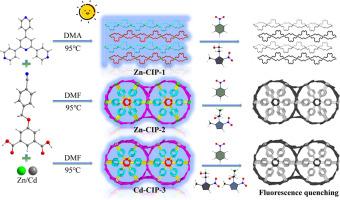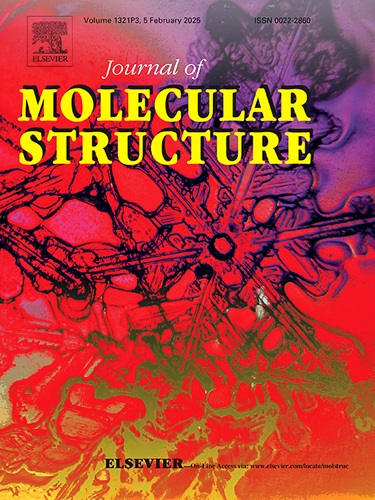用于检测抗生素/硝基芳香族化合物的三种发光 Zn/Cd 基 MOFs 及其淬灭机制研究
IF 4
2区 化学
Q2 CHEMISTRY, PHYSICAL
引用次数: 0
摘要
精确控制实验条件对于合成金属有机框架(MOFs)以实现抗生素和硝基芳香化合物的多功能检测至关重要。本研究采用 5-(4-氰基苄基)间苯二甲酸(5-H2CIP)和 4′-(4′'-吡啶基)-2,4′:6′,4′'-三吡啶配体(吡啶),在不同的水热合成条件下合成了三种 MOFs(Zn-CIP-1、Zn-CIP-2 和 Cd-CIP-3)。Zn-CIP-1 ([Zn(CIP)(pyterpy)]-2H2O)呈现二维层状骨架结构,而 Zn-CIP-2 ([Zn3(CIP)3(pyterpy)2-1-5H2O])和 Cd-CIP-3 ([Cd3(CIP)3(pyterpy)2])是具有三维拓扑结构的同构晶体。Zn-CIP-1 可选择性地检测水溶液中的甲硝唑(MET),Zn-CIP-2 可检测水溶液中的奥硝唑(ORN)。Cd-CIP-3 在 MET 或 ORN 的作用下会出现明显的荧光淬灭。这些 MOFs 还能检测水溶液中的硝基苯(NB),但淬灭比例各不相同。实验和密度泛函理论表明,Zn-CIP-2 的主要淬灭机制包括静态/动态淬灭、竞争吸收和光诱导电子转移。对弱相互作用、电子激发和发射过程的分析表明,π-π堆积相互作用在电子转移过程中起着重要作用。这项研究为开发多功能荧光传感器提供了启示。本文章由计算机程序翻译,如有差异,请以英文原文为准。

Three luminescent Zn/Cd-based MOFs for detecting antibiotics/nitroaromatic compounds and quenching mechanisms study
Precise control of experimental conditions is essential for synthesizing metal-organic frameworks (MOFs) to enable multi-functional detection of antibiotics and nitroaromatic compounds. In this study, three MOFs (Zn-CIP-1, Zn-CIP-2 and Cd-CIP-3) were synthesized using 5-(4-cyanobenzyl)isophthalic acid (5-H2CIP) and 4′-(4′'-pyridyl)-2,4′:6′,4′'-terpyridine ligands (pyterpy) under varying hydrothermal synthesis conditions. Zn-CIP-1 ([Zn(CIP)(pyterpy)]·2H2O) exhibits a two-dimensional layered skeleton structure, while Zn-CIP-2 ([Zn3(CIP)3(pyterpy)2·1·5H2O] and Cd-CIP-3 ([Cd3(CIP)3(pyterpy)2]) are isomorphic crystals with three-dimensional topological structures. Zn-CIP-1 selectively detects metronidazole (MET) and Zn-CIP-2 detects ornidazole (ORN) in aqueous solutions. Cd-CIP-3 exhibits significant fluorescence quenching with MET or ORN. These MOFs can also detect nitrobenzene (NB) in aqueous solutions with different quenching percentages. Experiments and density functional theory reveal that the main quenching mechanism of Zn-CIP-2 includes static/dynamic quenching, competitive absorption, and photo-induced electron transfer. The analysis of weak interactions, electron excitation, and emission processes demonstrates the important role of π-π stacking interactions in electron transfer processes. This study offers insights into the development of multi-functional fluorescent sensors.
求助全文
通过发布文献求助,成功后即可免费获取论文全文。
去求助
来源期刊

Journal of Molecular Structure
化学-物理化学
CiteScore
7.10
自引率
15.80%
发文量
2384
审稿时长
45 days
期刊介绍:
The Journal of Molecular Structure is dedicated to the publication of full-length articles and review papers, providing important new structural information on all types of chemical species including:
• Stable and unstable molecules in all types of environments (vapour, molecular beam, liquid, solution, liquid crystal, solid state, matrix-isolated, surface-absorbed etc.)
• Chemical intermediates
• Molecules in excited states
• Biological molecules
• Polymers.
The methods used may include any combination of spectroscopic and non-spectroscopic techniques, for example:
• Infrared spectroscopy (mid, far, near)
• Raman spectroscopy and non-linear Raman methods (CARS, etc.)
• Electronic absorption spectroscopy
• Optical rotatory dispersion and circular dichroism
• Fluorescence and phosphorescence techniques
• Electron spectroscopies (PES, XPS), EXAFS, etc.
• Microwave spectroscopy
• Electron diffraction
• NMR and ESR spectroscopies
• Mössbauer spectroscopy
• X-ray crystallography
• Charge Density Analyses
• Computational Studies (supplementing experimental methods)
We encourage publications combining theoretical and experimental approaches. The structural insights gained by the studies should be correlated with the properties, activity and/ or reactivity of the molecule under investigation and the relevance of this molecule and its implications should be discussed.
 求助内容:
求助内容: 应助结果提醒方式:
应助结果提醒方式:


